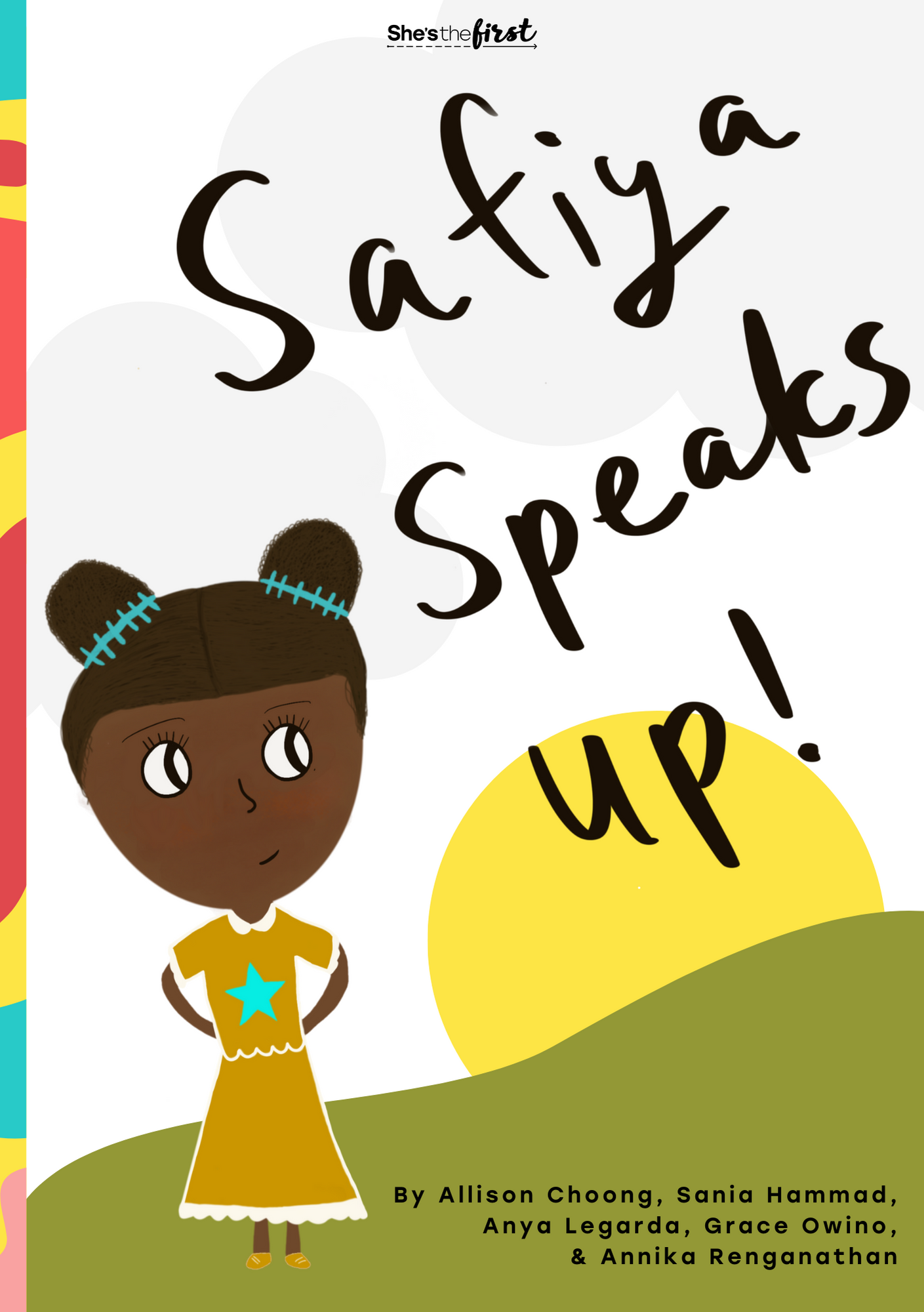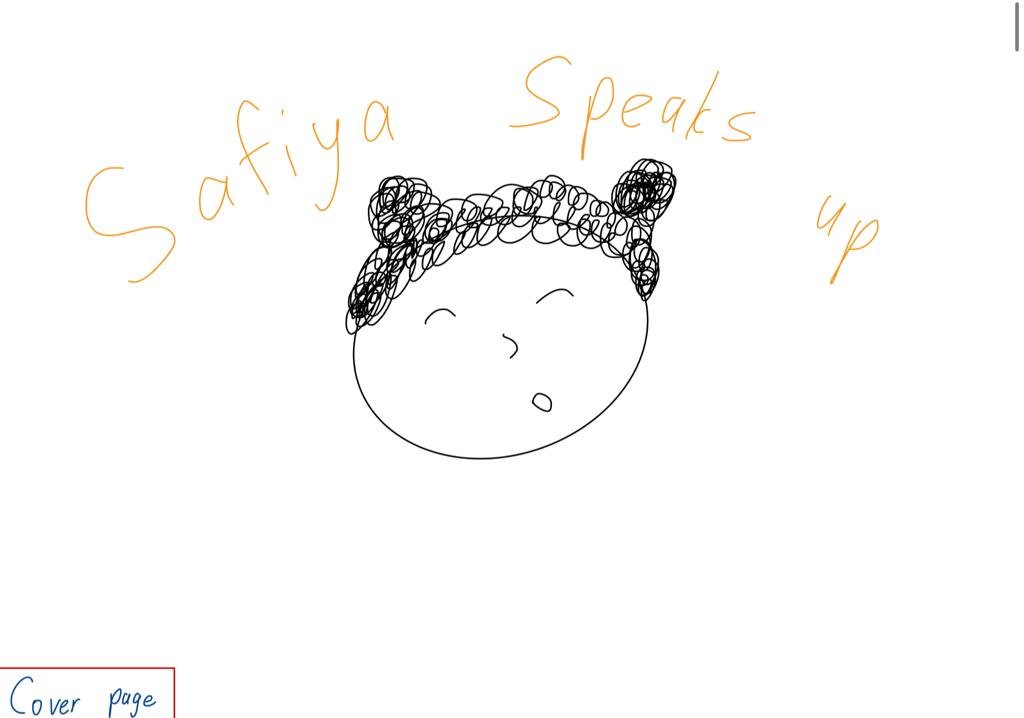Editor’s Note: Content Warning: sexual assault. Safiya Speaks Up is a children’s book and accompanying mentors’ guide to help young girls learn how to respond to sexual and domestic violence. After seeing a lot of misinformation and a lack of children-centered resources regarding safety from violence, our Girl Activist Fellows decided to write a children’s book for younger audiences to learn about safe and unsafe touch and identifying a safe adult. They hope that this resource will make this difficult conversation more accessible and easier to have with young children.
If you have experienced sexual assault, there are resources to help you. A list of hotlines by country is available in the mentors’ guide of Safiya Speaks Up.
Not sure what to say when a survivor shares her story with you? Start here: “I’m sorry this happened to you. It's not your fault. You did nothing wrong.”
By Anya Legarda, She’s the First Girl Activist Fellow
Today celebrates the launch of Safiya Speaks Up, a children’s book and mentor’s guide written by five girls between the ages of 15 and 21 from the She’s the First’s Girl Activist Fellowship: Allison Choong, Sania Hammad, Grace Owino, Annika Renganathan, and me, Anya Legarda. This “tell-all” is a memoir of the stories behind the book, as well as the memories we shared throughout its creation.
More than a year ago to this day, She’s the First opened applications for their Girl Activist Fellowship, which aids girls with the tools they need to spearhead advocacy campaigns for their rights in their families, communities, and societies. The campaigns are inspired by The Global Girls’ Bill of Rights®. I chose to join the Safety from Violence committee as the pains of girlhood are very real, and I wanted to help young girls navigate through the differences between safe touch and unsafe touch. After all, for an assaulter, abuse costs a few minutes, but to a girl — it's her whole life. To this, co-creator of Safiya Speaks Up Sania shared:
After my original committee disbanded, I had the opportunity to choose which group I would be part of. I had been to all the group meetings so I had heard everybody's plans for their projects. I thought that the Safety from Violence group would have the most impact because according to the Rape Abuse Incest National Network (RAINN), every nine minutes, Child Protective Services finds evidence of a claim of child sexual abuse. RAINN further states that one in nine girls under the age of 18 experiences sexual abuse or assault. With that high of numbers, we must ask ourselves how a child is supposed to know what is considered inappropriate touching, let alone how to respond to someone doing it to them. They're not going to inherently know what to do in that situation, which is why we need child-centered resources like Safiya Speaks Up to empower kids to know that there is such a thing as an unsafe touch, and if somebody's touching them in a way that makes them uncomfortable, they can speak up to a trusted adult.
The duration of this fellowship was done remotely from four countries: Allison in Malaysia; myself in the Philippines; Grace in Kenya; and Annika and Sania in the U.S. Allison and I had the pleasure of being in the same time zone, so oftentimes, our meetings would last until midnight. Meanwhile, the rest of the group woke up in the first flush of the morning. With distance and time zones as obstacles, we often joke that we would just bear the time difference for each other.
Moving forward into many meetings later, my team and I decided that we wanted to create a book that connected many girls with a single story. Allison then explained:
At the time we were thinking of ideas for our fellowship project, I had experienced sexual assault. I started thinking of children who were much younger than me who may not be able to identify things such as being assaulted or wrongfully treated. What happens to them? Who will guide them? For this reason, I wanted the children’s book to happen. After seeing a lot of misinformation and lack of children-centered resources for audiences regarding safety from violence, we decided to provide a resource for younger audiences to be aware of their rights to safety.
“With this book, we hope to destigmatize such a heavy issue and provide increased awareness and education around this topic.”
An early sketch of Safiya
With the decision to create a children’s book came the idea of Safiya, a girl navigating the distinctions between uncomfortable and safe interactions in her community. She is a product of both our imaginations and the realities of our societies, as her story represents persons of color who might be exposed to sexual violence. In addition, the name “Safiya” means “friend” in Arabic — showing that she is a friend to all girls.
Moreover, art is her form of release and self-expression, to which Sania revealed, “she has a lot of pent-up feelings that she feels she can’t express to others using words. Sometimes, it's hard to verbalize emotions, so art is a form of therapy to express how she feels.”
An illustration from Safiya Speaks Up.
Meanwhile, Safiya’s abuser, Uncle Adam, is displayed as a faceless figure in still, black tones. Early on, we knew that this would best represent who he is to Safiya, as the usage of this color signifies a time of uncertainty and emptiness for her. His single illustration in all black alludes to the idea that Safiya thinks of him as a man of much mystique and desire for secrecy.
In light of bringing these characters to life, Allison spoke of her time illustrating the book. She shared:
Despite having no experience in visual art, I decided to take the challenge of fully illustrating the book. From stickmans, to sketches, to full coloured pages, this experience of illustrating Safiya Speaks Up wasn’t easy. With approximately 4 hours of work on each page of illustration, this book is now truly a part of me and I am so grateful for the chance to illustrate Safiya’s story for the world.
We went through many book titles, two of which were Safiya Stands Up and Safiya Has a Secret. However, we decided to change it to Safiya Speaks Up. Annika accounted:
With the idea of making the title “Safiya Stands Up,” she would stand up for herself, whereas in “Safiya Has a Secret,” she feels as if her experience is meant to be hidden — something that many sexual and domestic violence victims feel. With this, we ended up with “Safiya Speaks Up,” as it acknowledges that you don't have to be the most confident or you don't have to be in the best mental space to be able to stand up for yourself and address your feelings. She was garnering all her bravery to speak up against her abuser. Moreover, this title acknowledges that there are a lot of emotions that go through a victim's head when they are in this situation. So I think it's the perfect balance; we chose this title because we wanted to show both sides of the spectrum.
In this light, we created an accompanying mentor’s guide along with the book. According to Grace, “the mentor’s guide acts as an area of reference for guardians and educators. With this tool, they will get a greater understanding of how to pinpoint abuse, as well as how to help young girls respond to sexual and domestic violence.”
The incorporation of hand prints in both the book and the mentor’s guide was something we were all adamant about from the beginning of the illustration process. Grace further shared, “The different colors and forms of handprints signify different people from various areas — meaning Safiya is representing all the girls all over the world who are going through sexual violence.”
To this, Annika added:
We use hand prints to signify that actions like this have a lasting impact. In terms of sexual and domestic violence, scars don't just go away, and the pain is often internalized. But like Grace said, I think the hand prints also symbolize unity — there are many girls who experience the same battles in every country.
A year in the making later, Safiya Speaks Up is yours just as it is ours. I was lucky enough to tell Safiya’s story with the most warm-spirited, gifted young women who I call friends for life. Writing this book alongside them has been the most moving, heart-filled experience for us all, and we are eager to show all that is in-store for this book in our communities. This is to all the girls around the world: know that you have the right to safety from all forms of violence.
The authors: Annika, Allison, Anya, Sania, and Grace
To download the book and accompanying mentor’s guide, head to shesthefirst.org/safiya-speaks-up.
Anya Legarda, 16, is a grade 10 student residing in Manila, Philippines. She is a staff writer for her school’s student-led publication. Her work has also been published by Girl Up and Kids for Kids. Anya is a Girl Activist Fellow for She’s the First, a program that teaches girls advocacy skills to speak up for themselves and their peers at local and global levels. For fun, she enjoys traveling, watching early 2000s Rom-Coms (or sad, old films), reading books, having skincare nights, listening to music, and visiting friends and family.












